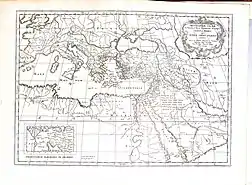Eastern Mediterranean
Eastern Mediterranean [1][2][3][4] is a loose definition of the eastern approximate half, or third, of the Mediterranean Sea (its lowest common denominator being the Levantine Sea). It typically embraces all of that sea's coastal zones, referring to communities connected with the sea and land greatly climatically influenced, in Southeast Europe, northern Egypt and far Western Asia. It includes the southern half of Turkey's main region Anatolia, its smaller Hatay Province, the island of Cyprus, the Greek Dodecanese islands, the region of Syria (in the Levant), Lebanon, Israel and Palestine.
Its broadest uses can embrace the Libyan Sea thus Libya; the Aegean Sea thus European Turkey (East Thrace), the mainland and islands of Greece; and a central part of the Mediterranean, the Ionian Sea, thus southern Albania in Southeast Europe reaching, west, to Italy's farthest south-eastern coasts. Jordan is climatically, and economically, part of the region.
Regions

This eastern Mediterranean region is commonly interpreted in two ways:
- The more broad definition of the Levant which includes its historically tied neighboring countries, Balkans and islands of Greece.
- The region of Syria with the island of Cyprus (also known as the Levant), Egypt, Greek Dodecanese and Anatolian Turkey.
Countries
The countries and territories of the Eastern Mediterranean include Cyprus, Greece, Palestine, Lebanon, Syria, Jordan, Turkey, Egypt,[5] and Israel.[6][7][8][9]
North-eastern Mediterranean has been put to print as a term for the Greater Balkans: Albania, Bosnia and Herzegovina, Bulgaria, Croatia, Greece,[7][8] Slovenia, North Macedonia, Serbia, Kosovo, Montenegro, Romania.[6] A five-author statistics-rich study of 2019 has sought to add Moldova and Ukraine beyond, which others link more to the Black Sea's economy and history.[6] The three-word term is mainly a complex euphemism for the Balkan peninsula used by those who stigmatise the word due to the term, as the signifier for the breakup of a empire's provinces, Balkanisation and narrower civil wars almost 100 years later. It is also used as a reminder or argument that social issues have parallels and links, such as in arms provision, to other conflicts of the Eastern Mediterranean.[6]
The WHO Regional Office for the Eastern Mediterranean includes the Eastern Mediterranean as well as the other Muslim-majority regions of contiguous Afro-Eurasia: the Middle East, North Africa, the Horn of Africa, and Central Asia.
See also
References
- "Eastern Mediterranean Political Map". National Geographic Store. National Geographic Society. Archived from the original on 21 February 2018. Retrieved 17 October 2011.
- Gore, Rick (17 October 2002). Clark, Robert (ed.). "Ancient Ashkelon". National Geographic Magazine. National Geographic Society. Archived from the original on 16 July 2012. Retrieved 17 October 2011.
- Franks, Tim (6 November 2011). "The state of Israel: Internal influence driving change". BBC News. BBC. Retrieved 4 October 2018.
- Orfalea, Gregory (2006). The Arab Americans: A History. Northampton, MA: Olive Branch Press. p. 249. ISBN 9781566565974.
- The Report: Egypt 2010. Oxford Business Group. ISBN 9781907065170 – via Google Books.
- Brauch, Hans Günter; Liotta, Peter H.; Selim, Mohammad El-Sayed; Rogers, Paul F. (28 September 2018). Security and Environment in the Mediterranean: conceptualising security and environmental conflicts : with 177 figures and 144 tables. Springer Science & Business Media. ISBN 9783540401070 – via Google Books.
- Diez, Thomas (28 September 2018). The European Union and the Cyprus Conflict: Modern Conflict, Postmodern Union. Manchester University Press. ISBN 9780719060793 – via Google Books.
- Springer-Verlag (28 September 2018). Mediterranean Climate: Variability and Trends. Springer Science & Business Media. ISBN 9783540438380 – via Google Books.
- Lucarelli, Sonia; Fioramonti, Lorenzo (16 October 2009). External Perceptions of the European Union as a Global Actor. Routledge. ISBN 9781135239497 – via Google Books.